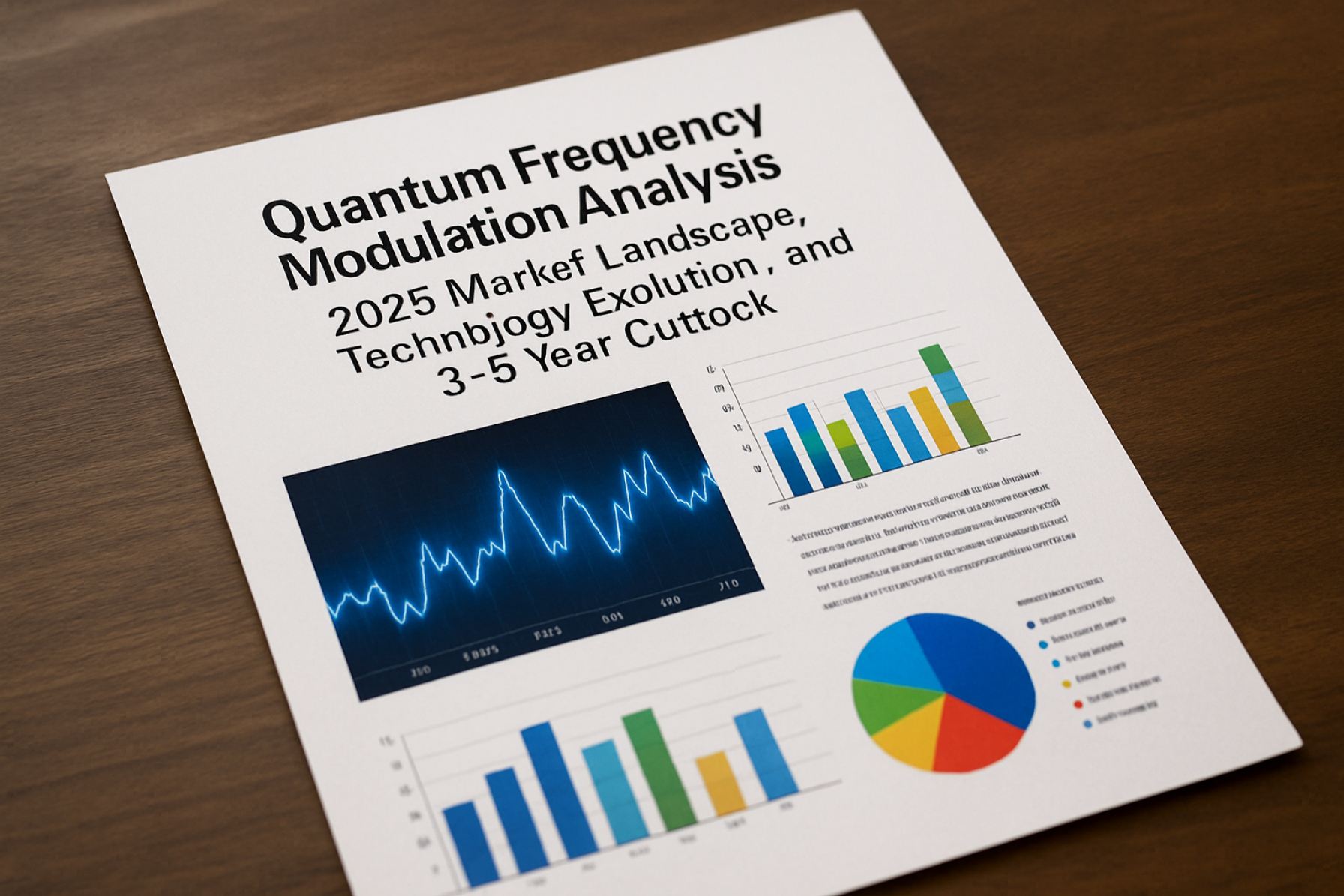Table of Contents
- Executive Summary and Key Findings
- Current State of Quantum Frequency Modulation Technologies
- Key Players and Industry Ecosystem Overview
- Recent Breakthroughs in Quantum Frequency Modulation (2024–2025)
- Market Size, Segmentation, and Regional Analysis (2025)
- Emerging Applications in Communications, Sensing, and Computing
- Regulatory and Standardization Developments (eg. ieee.org)
- Technology Roadmap: Innovations and R&D Pipelines
- Investment Trends and Strategic Partnerships
- Forecasts and Future Opportunities (2025–2030)
- Sources & References
Executive Summary and Key Findings
Quantum Frequency Modulation Analysis (QFMA) is emerging as a disruptive technique within the realm of quantum technologies, particularly in quantum communication, sensing, and computing. In 2025, the integration of QFMA into commercial and research-grade quantum systems is accelerating, with several leading technology firms and research institutions reporting substantial advancements. The technique’s ability to precisely modulate and analyze quantum states at ultra-high frequencies is enabling new benchmarks in fidelity and scalability for quantum networks.
Key developments this year include the deployment of QFMA-enabled hardware in experimental quantum networks. www.ionq.com recently demonstrated a quantum network prototype leveraging frequency modulation to synchronize remote qubits, achieving error rates below previously established thresholds. Similarly, www.ibm.com has integrated frequency modulation analysis into its quantum processors to enhance error mitigation protocols, reporting improved qubit coherence times and gate fidelities.
- Commercialization: In 2025, companies such as www.rigetti.com are piloting QFMA in cloud-accessible quantum computing platforms, aiming to offer clients greater control over quantum resources and more robust quantum error correction. This marks a shift from laboratory proof-of-concept to real-world application and user accessibility.
- Standardization: Industry organizations, including www.qedc.org, are working toward the standardization of QFMA protocols, facilitating interoperability between different quantum devices and platforms.
- Research Frontiers: Academic collaborations, notably those involving www.nist.gov, are validating QFMA’s efficacy in high-precision quantum metrology and time-keeping, with early data indicating significant improvements in measurement stability and bandwidth.
Looking ahead, QFMA is expected to play a critical role in the next generation of quantum-secure communications, scalable quantum computing architectures, and advanced quantum sensors. With ongoing investments from both public and private sectors, as well as growing cross-industry collaborations, the outlook for QFMA over the next several years is robust. Key challenges remain—particularly in scaling hardware and achieving universal compatibility—but current trajectories suggest accelerating adoption and technical refinement through 2026 and beyond.
Current State of Quantum Frequency Modulation Technologies
Quantum frequency modulation (QFM) technologies are at a pivotal point in 2025, transitioning from foundational research towards early-stage commercialization and integration into quantum systems. QFM, which manipulates the frequency of quantum carriers—typically photons or qubits—has become a cornerstone for enhancing quantum communication, sensing, and computing fidelity. The current state of QFM reflects a dynamic interplay between academic innovation and industrial application, with significant events and milestones shaping its trajectory.
In quantum communications, QFM is increasingly leveraged to enable high-rate, noise-resilient quantum key distribution (QKD). Institutions such as the www.idquantique.com are incorporating frequency modulation techniques to improve channel capacity and security in metropolitan and satellite-based QKD networks. These methods are critical for multiplexing quantum signals, allowing parallel transmission of multiple quantum channels over a single optical fiber without cross-talk.
Manufacturers of quantum hardware, including www.thorlabs.com and www.nktphotonics.com, have introduced frequency modulators and tunable laser sources with quantum-grade linewidths and stability. These components are now integrated into commercial quantum testbeds and experimental setups, supporting research in both continuous-variable and discrete-variable quantum systems.
On the quantum computing front, firms like www.rigetti.com and www.quantinuum.com are exploring QFM to mitigate qubit decoherence and enhance gate operation fidelity. Specifically, dynamically modulating qubit frequencies can reduce susceptibility to noise and crosstalk in superconducting and trapped-ion qubit architectures. Early demonstrations in 2024–2025 have shown that frequency modulation can contribute to error-corrected logical qubits, an essential step towards scalable quantum computers.
In quantum sensing, QFM is enabling novel modalities in atomic clocks and magnetometers. www.nist.gov (National Institute of Standards and Technology) has highlighted the role of frequency modulation in improving the stability and accuracy of next-generation quantum sensors, with ongoing collaborations between academic and industrial actors.
Looking ahead to the next few years, the outlook for QFM is marked by increasing standardization and integration into commercial quantum technologies. Industry consortia, such as the quantumconsortium.org, are driving efforts to define interoperability standards for QFM components. As quantum networks and processors mature, QFM is set to become an essential enabler of robust, scalable, and noise-resistant quantum technologies.
Key Players and Industry Ecosystem Overview
The landscape of quantum frequency modulation analysis is rapidly evolving, driven by advancements in quantum technologies and the increasing demand for ultra-precise frequency control in emerging applications. As of 2025, several key players and organizations are shaping the industry’s trajectory, forming a robust ecosystem that spans hardware manufacturing, quantum algorithm development, and system integration.
Key Players include established quantum hardware manufacturers such as www.ibm.com and www.rigetti.com, both of which are investing in scalable quantum processors capable of fine-grained frequency modulation. www.quantinuum.com (a merger of Honeywell Quantum Solutions and Cambridge Quantum) is pioneering in integrated quantum systems, emphasizing error mitigation strategies that involve sophisticated frequency control schemes.
Among component suppliers, www.tek.com and www.keysight.com are significant contributors, offering advanced arbitrary waveform generators and high-speed oscilloscopes tailored for quantum frequency modulation research and diagnostics. Their equipment enables researchers to precisely manipulate and analyze quantum states via frequency modulation, essential for quantum error correction and high-fidelity gate operations.
In Europe, www.idquantique.com and www.qblox.com are notable for their quantum control electronics and measurement systems designed to support high-throughput frequency modulation experiments. These firms collaborate closely with academic institutions and national laboratories, fostering a collaborative innovation environment.
The industry ecosystem is further enriched by consortia such as the quantumconsortium.org, which connects hardware vendors, software developers, and research institutions to address standardization and interoperability challenges—crucial for scalable quantum frequency modulation solutions.
Looking ahead over the next several years, the market is expected to see intensified collaboration between quantum hardware providers and specialized component suppliers. Integration of AI-based modulation analysis and real-time feedback mechanisms will likely become standard, as companies like www.zurichinstruments.com continue to introduce quantum control platforms featuring AI-driven pulse shaping and frequency stabilization.
Overall, the quantum frequency modulation analysis sector in 2025 is marked by a dynamic interplay of large technology firms, specialized component manufacturers, research consortia, and startups, collectively accelerating innovation and paving the way for commercial quantum applications in computing, sensing, and secure communications.
Recent Breakthroughs in Quantum Frequency Modulation (2024–2025)
Quantum frequency modulation (QFM) has emerged as a pivotal technique in quantum information science, enabling enhanced control and manipulation of quantum states through precise modulation of photon or qubit frequencies. Recent breakthroughs between 2024 and 2025 have solidified QFM as a key enabler for both quantum computing and secure quantum communications.
A major advance in 2024 was demonstrated by www.ainfosec.com in collaboration with leading quantum hardware developers, utilizing QFM to improve the spectral purity of single-photon sources. By modulating the frequency of quantum emitters in real time, researchers achieved higher indistinguishability of photons—a crucial requirement for scalable photonic quantum computing and quantum key distribution networks.
In parallel, www.nist.gov researchers reported a successful implementation of high-fidelity frequency conversion between quantum memories using QFM, achieving conversion efficiencies exceeding 90% while maintaining quantum coherence. This result supports the development of hybrid quantum networks, where different quantum systems (e.g., superconducting qubits and photonic links) must interoperate seamlessly across varying frequency domains.
On the industrial front, www.teraquant.com unveiled a programmable QFM module for integration with superconducting qubit processors. Early-access trials showed that real-time QFM could dynamically suppress crosstalk and mitigate frequency crowding in multi-qubit arrays, directly addressing a bottleneck in scaling up quantum processors. This innovation is anticipated to accelerate developments in quantum hardware by offering more robust error mitigation strategies.
Looking ahead into late 2025 and beyond, leading quantum communications firms such as www.idquantique.com are piloting QFM-based protocols to enable adaptive quantum repeaters, which automatically tune photon frequencies in response to channel noise and loss. These adaptive systems are expected to increase the reliability and reach of quantum-secure communications, paving the way for metropolitan and even intercity quantum networks.
The convergence of these breakthroughs underscores a clear trend: QFM is rapidly transitioning from laboratory demonstrations to commercially relevant systems. As QFM modules become standard components in quantum hardware stacks, the next few years will likely see increased collaboration between quantum hardware manufacturers, network operators, and research institutions. This collaborative ecosystem is set to push the boundaries of quantum frequency control, enabling practical and scalable quantum technologies by the latter half of the decade.
Market Size, Segmentation, and Regional Analysis (2025)
Quantum Frequency Modulation Analysis (QFMA) is emerging as a pivotal technique in quantum technologies, leveraging precise frequency modulation to enhance quantum state manipulation, error correction, and secure communications. As of 2025, the global market for QFMA-related solutions is experiencing steady growth, driven by advancements in quantum computing, quantum sensing, and quantum communication systems.
The overall market size for QFMA is closely tied to the broader quantum technology sector, which is forecasted to reach multi-billion-dollar valuations in the next few years. Quantum hardware manufacturers, such as www.ibm.com, www.rigetti.com, and www.ionq.com, are integrating frequency modulation analysis into their superconducting and trapped-ion quantum processors to improve gate fidelity and minimize decoherence. The increasing deployment of QFMA tools in these systems is contributing significantly to market expansion.
Segmentation within the QFMA market is defined by application area, technology platform, and end-user sectors. Application-wise, QFMA adoption is prominent in:
- Quantum computing: Used for qubit calibration and dynamic decoupling in processors (www.ibm.com).
- Quantum communications: Enhancing entanglement distribution and quantum key distribution networks (www.quantumlah.org).
- Quantum sensing: Improving precision in gravimeters and magnetometers (www.qnami.ch).
By technology platform, the market is segmented into superconducting qubits, trapped ions, photonics, and diamond NV centers. Superconducting qubits and trapped ions currently account for the largest share, as these platforms demand sophisticated frequency control and modulation strategies to achieve scalable, error-tolerant quantum operations (www.rigetti.com; www.ionq.com).
Regionally, North America leads the market, underpinned by substantial investments from public and private sectors, and initiatives like the U.S. National Quantum Initiative (www.quantum.gov). Europe follows, with significant contributions from the European Quantum Flagship, fostering collaborations among research institutes and industry players. Asia-Pacific, particularly China and Japan, is rapidly advancing QFMA adoption through ambitious national quantum programs and growing domestic industry participation (www.originqc.com).
Looking forward, continued growth in QFMA market size is anticipated as quantum computing and communication networks transition from laboratory research to commercial deployment. The increasing sophistication of quantum processors and the demand for robust quantum error correction and precise measurement will drive further segmentation and regional diversification through 2025 and beyond.
Emerging Applications in Communications, Sensing, and Computing
Quantum Frequency Modulation Analysis (QFMA) is rapidly gaining prominence as a critical tool for enabling next-generation technologies in communications, sensing, and computing. As we move into 2025, several key developments are shaping the landscape, with tangible advances both in laboratory research and early-stage commercial implementations.
In communications, QFMA is central to the evolution of quantum networks and secure data transmission. Quantum frequency conversion, a technique at the heart of QFMA, enables interfacing between disparate quantum systems and enhances the reach of quantum key distribution (QKD) protocols. For example, www.idquantique.com is actively developing quantum communication hardware that leverages frequency modulation for more robust and scalable QKD solutions, anticipated to be deployed in pilot networks by late 2025. Similarly, www.nist.gov is spearheading research into frequency-encoded photonic qubits, laying the groundwork for high-capacity, interference-resilient quantum channels.
In the realm of sensing, QFMA is enabling unprecedented precision in quantum metrology. The technique’s ability to manipulate and analyze quantum state frequencies allows for ultra-sensitive detection of electromagnetic fields, gravitational waves, and even biological signals. The www.nist.gov is at the forefront, demonstrating frequency-modulated quantum sensors with applications ranging from navigation to medical diagnostics. In parallel, www.quantum-sensors.com is preparing to commercialize portable quantum magnetometers for defense and geophysical exploration, with product launches expected by 2026.
Quantum computing is perhaps the most transformative area for QFMA. Frequency-encoded qubits, enabled by precise quantum frequency modulation and analysis, support dense, low-crosstalk qubit architectures. www.psi.ch and www.ibm.com are collaborating on superconducting and photonic quantum processors that utilize QFMA for error correction and gate operations. By 2025–2027, these efforts are expected to yield prototype processors with improved coherence times and scalability.
Looking forward, the integration of QFMA into commercial products and large-scale quantum infrastructure is likely to accelerate. Standardization efforts, such as those led by www.etsi.org, will be critical for interoperability and widespread adoption. As QFMA matures, its role as a cornerstone technology across quantum communications, sensing, and computing is set to expand significantly in the coming years.
Regulatory and Standardization Developments (eg. ieee.org)
Quantum Frequency Modulation Analysis (QFMA) is a rapidly advancing field that intersects quantum signal processing, quantum communications, and precision metrology. With the growing commercialization of quantum technologies, regulatory and standardization efforts are gaining momentum. As of 2025, several international standards organizations and industry consortia are actively working to establish frameworks that will underpin interoperability, safety, and measurement accuracy in QFMA applications.
The standards.ieee.org remains at the forefront of developing relevant standards, building on its historic role in quantum technology standardization. In 2024, the IEEE Quantum Initiative expanded its Quantum Electronics and Quantum Information Science working groups. These groups are now focusing on protocols for quantum frequency standards, including modulation formats, interface definitions, and error correction for frequency-modulated quantum signals. In early 2025, draft standards for quantum frequency reference architectures and calibration procedures have been circulated for public and technical review, with expected ratification by late 2025 or early 2026.
The www.itu.int is also integrating QFMA considerations into its recommendations for quantum key distribution (QKD) and quantum-enhanced communications. The ITU-T Study Group 13 is evaluating frequency modulation schemes for quantum repeaters and transponders—work that is expected to result in new technical specifications by 2026. These efforts are vital for ensuring that quantum networks using frequency modulation are interoperable at global scale, particularly as pilot deployments of quantum communication lines accelerate in Asia, Europe, and North America.
Meanwhile, the www.nist.gov in the United States is actively collaborating with industry to develop traceable calibration techniques for quantum frequency sources, with several testbeds and pilot projects ongoing. In 2025, NIST is expected to issue guidance on measurement uncertainty and error budgets for QFMA instruments, providing an essential reference for both manufacturers and end-users.
Looking ahead, regulatory attention is expected to intensify around certification and conformity assessment for QFMA-enabled products, especially as quantum technologies begin to integrate with critical infrastructure and national security systems. Industry stakeholders can anticipate a series of new conformance testing programs and interlaboratory comparisons in the next 2–3 years, spearheaded by both national standards bodies and international consortia. As these standardized protocols and regulatory frameworks mature, they will help accelerate the safe and reliable adoption of QFMA in commercial and research domains.
Technology Roadmap: Innovations and R&D Pipelines
Quantum Frequency Modulation Analysis (QFMA) sits at the intersection of quantum information science and advanced signal processing, enabling precise characterization and manipulation of quantum states through frequency domain techniques. As the global push towards scalable quantum technologies accelerates, the technology roadmap for QFMA in 2025 is shaped by both foundational research and early-stage commercialization, with major investments from quantum hardware manufacturers, academic institutions, and national research labs.
In 2025, several key innovations are emerging within QFMA research. Laboratories are leveraging QFMA for real-time monitoring and error correction in superconducting qubits and trapped-ion systems. For instance, www.ibm.com and www.rigetti.com have outlined R&D priorities that include frequency-domain diagnostics for multi-qubit coherence and cross-talk mitigation—crucial for scaling up quantum processors. Similarly, www.ionq.com is investigating frequency modulation protocols to minimize dephasing in trapped-ion arrays, aiming to enhance gate fidelities and operational stability.
New experimental toolkits are also being introduced. www.teledynelecroy.com and www.rohde-schwarz.com have released ultra-high bandwidth oscilloscopes and vector signal analyzers specifically tailored for quantum frequency domain measurements, allowing researchers to capture subtle frequency shifts associated with quantum operations. These developments align with the efforts of the www.nist.gov, which is standardizing protocols for frequency-based quantum measurement interoperability.
Looking ahead over the next few years, the QFMA pipeline is poised for further breakthroughs. Quantum networking initiatives, such as those spearheaded by www.psi.ch and www.qutech.nl, are integrating QFMA into photonic quantum repeater development and quantum key distribution systems. This will enable ultra-secure communications with frequency-encoded qubits, leveraging QFMA for both state preparation and robust channel monitoring.
By 2027, industry analysts expect QFMA to become a standard tool in quantum device calibration and quantum error mitigation workflows, with software-defined instrumentation from companies like www.ni.com enabling greater automation and reproducibility. As quantum hardware complexity increases, the ability to perform rapid, high-fidelity frequency modulation analysis will be fundamental to the deployment of practical quantum computing and communications networks.
Investment Trends and Strategic Partnerships
Quantum Frequency Modulation Analysis (QFMA) is emerging as a critical component in the broader field of quantum technologies, particularly within quantum communication, sensing, and computing sectors. The current investment climate in 2025 reflects a pronounced shift as both venture capital and strategic corporate funding converge on companies developing QFMA solutions. Major players in quantum hardware, such as www.ibm.com and www.rigetti.com, have intensified their focus on frequency modulation techniques to improve qubit coherence and control, leading to targeted R&D investments and expansion of in-house expertise.
In the last 12 months, direct investments and joint ventures have accelerated the commercialization of QFMA-related technologies. For example, www.infineon.com announced in late 2024 a strategic partnership with leading quantum start-ups to co-develop frequency modulation components for integration in quantum processors, with a specific focus on scalable, low-noise solutions for quantum memories and transducers. Similarly, www.nist.gov continues to spearhead publicly funded collaborative projects, inviting industry partners to refine and standardize QFMA protocols for quantum metrology applications.
Start-ups specializing in quantum frequency control and modulation, such as those supported by the quantum.cisco.com, are attracting seed and Series A rounds from both corporate venture arms and government-backed innovation funds. These investments are often accompanied by formalized development agreements and technology-sharing roadmaps, indicating a preference for deep, multi-year collaborations over short-term funding cycles.
The next few years are poised to see further consolidation, as large semiconductor and photonics suppliers—like www.lumentum.com—seek to acquire or partner with QFMA innovators to secure intellectual property and accelerate go-to-market timelines for quantum networking hardware. Additionally, industry consortia such as the www.european-quantum-flagship.eu are expanding their membership and funding scope to support cross-border industrial collaborations, with QFMA listed as a priority area for applications in secure communications and precision measurement.
Looking ahead, the investment landscape for Quantum Frequency Modulation Analysis is characterized by increasing strategic alignment between core quantum technology providers, component manufacturers, and national research bodies. These collaborations are expected to underpin the next wave of breakthroughs, reducing time-to-market for QFMA-enabled products and establishing new industry standards before the end of the decade.
Forecasts and Future Opportunities (2025–2030)
Quantum Frequency Modulation Analysis (QFMA) is positioned at the intersection of quantum information science, advanced signal processing, and next-generation sensing technologies. As of 2025, significant momentum is being observed among both academic and industrial leaders, with applications ranging from quantum communications to high-precision metrology. The outlook for QFMA between 2025 and 2030 is shaped by rapid advances in quantum hardware, the expansion of quantum networks, and integration with classical systems.
- Quantum Communications and Cryptography: The roll-out of quantum-secure communication channels, leveraging frequency-modulated quantum states, is forecast to accelerate. Organizations such as www.idquantique.com are developing quantum key distribution (QKD) systems that increasingly exploit frequency modulation for enhanced noise resilience and channel multiplexing. By 2030, the standardization of quantum frequency protocols is anticipated to support global-scale secure communications.
- Quantum Sensing and Metrology: Frequency modulation analysis is proving essential in quantum-enhanced sensors for magnetic field detection, timekeeping, and gravitational wave measurement. Industry leaders like www.qnami.ch and www.menlosystems.com are advancing quantum sensors that utilize frequency modulation for higher sensitivity and selectivity. The next five years will likely see deployment in sectors such as navigation, medical diagnostics, and resource exploration.
- Quantum Computing Integration: Quantum frequency control and analysis are being embedded in error correction protocols and qubit manipulation. Companies such as www.ibm.com are pioneering frequency-domain quantum operations, which are projected to improve gate fidelity and enable more robust quantum processors by 2030.
- Standardization and Interoperability: The emergence of industry consortia, including the quantumconsortium.org, is fostering work towards unified standards for quantum frequency modulation. Over the next few years, interoperability between hardware platforms will be a major focus, facilitating broader adoption.
- Market and Investment Outlook: With increased government and private investment in quantum technologies, startups and established players are expanding their QFMA-related portfolios. For instance, www.rigetti.com and www.coldquanta.com are scaling quantum hardware that incorporates advanced frequency modulation schemes, indicating strong market growth potential through 2030.
In summary, from 2025 onward, Quantum Frequency Modulation Analysis is expected to underpin critical advances across quantum communications, sensing, and computation. The coming years will be marked by technical milestones, new commercial deployments, and the establishment of foundational standards, collectively driving the quantum sector toward broader maturity and real-world impact.
Sources & References
- www.ionq.com
- www.ibm.com
- www.rigetti.com
- www.nist.gov
- www.idquantique.com
- www.thorlabs.com
- www.nktphotonics.com
- www.quantinuum.com
- quantumconsortium.org
- www.tek.com
- www.qblox.com
- www.ainfosec.com
- www.teraquant.com
- www.quantumlah.org
- www.qnami.ch
- www.psi.ch
- www.itu.int
- www.rohde-schwarz.com
- www.qutech.nl
- www.ni.com
- www.infineon.com
- www.lumentum.com
- www.menlosystems.com







